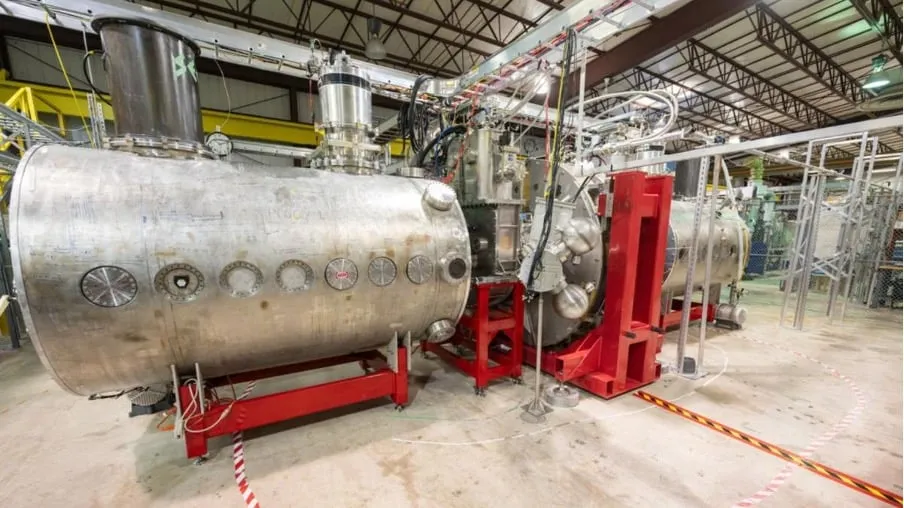Realta Fusion and UW Demonstrate Highest Ever Magnetic Field in Fusion Plasma Experiment
Using the strongest steady magnetic field ever applied to contain plasma in a magnetic mirror device, a new world record was set in July 2024. This was achieved by the Wisconsin HTS Axisymmetric Mirror (WHAM) experiment at the University of Wisconsin-Madison, and this team achievement marks a notable contribution to the field of fusion energy, potentially paving the way for more efficient and compact fusion reactors.

The WHAM device located in the University of Wisconsin-Madison. ©University of Wisconsin-Madison.
What Have They Done?
On the 15th of July 2024, the WHAM team, led by physics professor Cary Forest, successfully generated and held a plasma in a mirror device using a magnetic field strength of 17 Tesla on the confined plasma. This field was generated by high temperature superconducting magnets (HTS).
To put this into perspective, the Earth’s magnetic field is roughly 50 Microtesla, meaning that the WHAM team’s 17 Tesla field is roughly 350,000 times stronger. Or another way to explain it, the breakthrough record is roughly 17,000 times stronger than a standard fridge magnet (which is roughly 1 Millitesla). Professor Cary Forest of the University of Wisconsin and Chief Scientific Officer of Realta Fusion said; "With the WHAM experiment we have brought together advances in superconductor technology and plasma physics, to demonstrate the potential of the compact magnetic mirror as a fusion energy system."
Why is it Impressive?
WHAM has set a new record for magnetically confined plasmas. The highest ever steady state field in fusion plasma was recorded on the WHAM experiment by the Realta Fusion team.
In addition, WHAM also revives an older concept in fusion research: the magnetic mirror.
The magnetic mirror approach uses two high-field superconducting magnets either end of a tube to confine the turbulent fusion plasma in a “magnetic bottle”. The fusion company, Realta Fusion, describes the core principle: “The strong magnetic fields cause charged, energetic particles to bounce back and forth, also known as the mirror effect.” This mirror effect ensures the plasma remains confined, bouncing between the strong magnetic fields, allowing for improved control and stability, which is essential for fusion research and energy production.

Realta Fusion’s magnetic mirror concept. ©Realta Fusion
Firstly, it further demonstrates the viability of using HTS magnets in fusion devices, which can create much stronger magnetic fields than previously possible.
This increase in magnetic field strength has a dramatic effect on the efficiency of fusion reactions as fusion power scales with the fourth power of the magnetic field strength. This means that even a small increase in the magnetic field strength can lead to large gains in fusion power output.
Stronger magnets could lead to significantly more efficient and compact fusion devices, which would be cheaper to build than larger ones.
This project was a partnership between Realta Fusion, a University of Wisconsin-Madison spinoff, and the MIT spinout Commonwealth Fusion Systems (CFS).
CFS developed and produced the HTS magnets used to generate the 17 Tesla magnetic field. These powerful magnets, once chilled to their operating temperature and energised, produced the record-breaking magnetic field that confined the plasma within the WHAM device. Bob Mumgaard, CEO of Commonwealth Fusion Systems, said on LinkedIn: “It validates our strategy to use the powerful magnet technology we’re building for SPARC and ARC in applications outside CFS. It's great to see our tech delivered to a customer and working as intended in their system.”
Secondly, the WHAM experiment revitalises the magnetic mirror concept, which until the 1980s was a leading approach to fusion energy in the US. Advances in superconductor technology, particularly the development of HTS magnets, have overcome previous limitations, making the magnetic mirror a contender once again.
The WHAM experiment will provide valuable physics data for the field, and this success could open the door to re-evaluating other discarded fusion concepts, further growing the scientific foundations for fusion.
Finally, this work highlights the successful collaboration between academic research and private industry. The partnership between the University of Wisconsin-Madison and Commonwealth Fusion Systems exemplifies how active collaboration can drive innovation and lead to significant advancements by providing a direct feedback loop between research and the private sector.
What’s Next?
The WHAM team's achievement has profound implications for the future of fusion and the experiment now serves as a crucial testbed for the magnetic mirror reactor design.
Building on WHAM's success, Realta Fusion is gearing up to create two cutting-edge demonstration devices named Anvil and Hammir. Anvil will further refine WHAM’s design and collect comprehensive data whilst also accelerating material testing. Hammir, on the other hand, will introduce an updated design that includes multiple magnets, enabling the construction of longer reactors with significantly amplified power.
